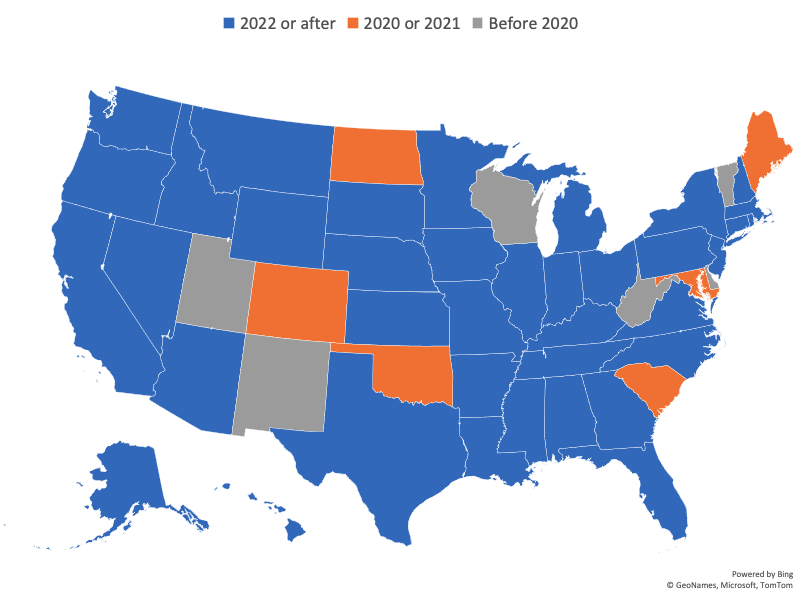Julie Harris
What do high school graduates need to know and be able to do to be prepared for college and career? This is the fundamental question that state policy makers confront when determining minimum high school graduation requirements or assessing whether these requirements need to change to meet the needs of a rapidly evolving economy. States typically set minimum course requirements to earn a high school diploma and some also specify assessments that students must complete to graduate. In some states, policymakers have created multiple diploma options or pathways to graduation to increase flexibility for students.
At the request of the DC Office of the State Superintendent of Education, researchers with the Region 4 Comprehensive Center (R4CC) reviewed graduation requirements from all 50 states plus the District of Columbia (D.C.). The resulting scan provides an overview of current trends in high school graduation requirements and may be useful to policymakers interested in revising their own graduation requirements.
Trends in changing graduation requirements
Thirty-eight states updated their graduation requirements in 2022 or 2023, while only six states had not updated their graduation requirements since before 2020 (Figure 1). In reviewing these changes, the R4CC team identified four major trends, described below.
Figure 1. Year states last made changes to graduation requirements

Increased emphasis on non-core-academic graduation requirements
States have long included a health education course as part of their graduation requirements, but many states are now adding additional non-core-academic requirements geared towards preparing healthy, financially literate, well-rounded, and engaged citizens:
- Eighteen states added a civics education course or exam requirement in the past ten years.
- One state and D.C. require community service.
- Seventeen states added a financial literacy course requirement in the past four years.
- Nine states now require CPR/first aid training.
- Three states require ethnic studies.
Promotion of science, technology, and math (STEM)
To keep up with the evolving economy, many states are encouraging students to take more science, technology, engineering, and math (STEM) courses by creating specific pathways for STEM diplomas and STEM diploma seals, or by requiring additional STEM courses beyond the standard math and science course requirements:
- Three states have STEM diplomas.
- Twelve states currently have a STEM diploma seal.
- Nine states have added a computer science or technology course requirement within the last five years, and most states recommend such courses or allow them to count towards math or science credit requirements.
Increased emphasis on career preparation
States are increasingly focusing on career preparation, either by requiring career and technical education (CTE) coursework or career-related activities, or by establishing an optional pathway to obtaining a diploma via CTE coursework.
- Seven states require CTE coursework, while 37 states and D.C. allow CTE courses as substitutions for other graduation requirements. About a third of the states have established sequences for obtaining a diploma or endorsement via career and technical education (CTE).
- Six states explicitly requiretransition, career, or postsecondary plans in their high school graduation policy.
Addition of competency-based options or requirements
As competency-based education gains traction, states are increasingly adding graduation requirements that rely on demonstrations of mastery or are providing flexibility to districts to allow students to demonstrate competencies in place of required course credits or assessments. Twenty-three states require districts to offer students competency-based options to meet some of the graduation requirements, including the following:
- A capstone project that involves a culminating, multifaceted research project that demonstrates a student’s ability to analyze and synthesize information across domains.
- An apprenticeship to fulfill career and technical education requirements.
- A standards-based portfolio.
- A project-based learning experience.
Resources
For a summary of other state high school graduation requirements (for example, assessments and dual enrollment), novel practices, and alternative diploma pathways, see the R4CC state graduation requirements executive summary.
For a more detailed overview of high school graduation requirements for each state, as well as a summary of best practices for high school completion and success from the What Works Clearinghouse, see High school graduation requirements scan.
For a review of the evidence conducted by the Region 2 Comprehensive Center on the relationship between college, career, and civic readiness (CCCR) indicators and postsecondary success, which high school experiences and opportunities contribute to CCCR, and whether offering flexible diploma pathways contributes to CCCR for all students, see Graduation requirements and measures: A review conducted for the New York State Board of Regents and the New York State Education Department (2022).



